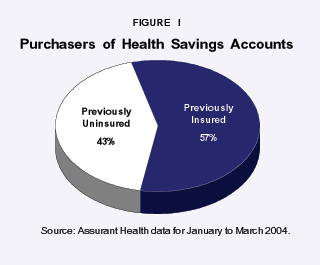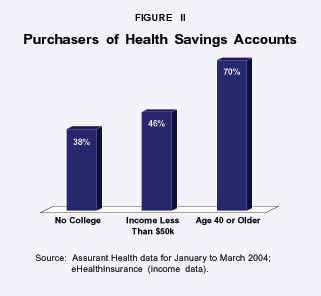Last year, as Congress debated what would become the Medicare Modernization Act (P.L. 108-173), the media and most policymakers focused on the elephant in the room – major changes being made to the Medicare program affecting over 40 million senior citizens. But a "mighty mouse" occupied the same room, and went largely unnoticed. The law also created "Health Savings Accounts" (HSAs), allowing individuals who purchase high-deductible insurance policies to establish tax-free savings accounts for health care expenses. Early data has surprised critics by showing that HSAs are encouraging many Americans to obtain health insurance and save for their futures. Most importantly, many of the new HSA owners were formerly uninsured, defying initial prophecies that the accounts would only be utilized by the "young, healthy and wealthy."
Proponents have argued that the combination of health insurance with an HSA creates a "win-win" for the consumer: an individual purchases a high-deductible plan, which is more affordable month to month, allowing those who are unable to purchase a "Cadillac" plan to become insured. Consumers then funnel some of their premium savings into an HSA account. Over time, they save enough to pay the deductible and other out-of-pocket expenses. For example, under a typical arrangement, an individual might have a $1,000 deductible and deposit $500 in an HSA. The first $500 of medical expenses is paid from the HSA; the next $500 out of pocket, and above $1,000 the insurer pays the bills with a copayment from the consumer until the annual out-of-pocket cap is reached. HSA funds not spent remain in the account and grow tax-free. After a few years, the HSA could have sufficient funds to pay most, if not all, expenses not paid by the insurance plan. A key feature of HSAs is that the account stays with the individual regardless of job transitions and he or she can continue to accumulate the savings until retirement.

HSAs became available to consumers on January 1, 2004, and real data is emerging to replace speculation. In the first six months, tens of thousands of Americans have purchased HSAs. Two companies have collected and shared demographics about who is purchasing HSAs. Assurant Health (formerly Fortis) is one of the largest carriers operating in the individual and small group markets, and eHealthInsurance is an online source of health insurance for individuals and small businesses, offering insurance products from a number of carriers nationwide. The data provide a broad-based look at what is happening in the market. They also help separate myth from fact.
Myth: HSAs will not help to reduce the numbers ofuninsured, because people without insurance coverage will be unable to afford an HSA policy.
Fact: HSAs have already reduced the number of uninsured Americans.
- Some 43 percent of HSA applicants did not indicate any prior coverage, according to Assurant. [See Figure I.]
- Nearly one-third (32.8 percent) of all HSA applicants to eHealthInsurance – and about half of those with incomes under $35,000 – had not had coverage for at least six months prior to enrollment.
Myth: Only the wealthy will purchase HSAs, because lower income individuals will not be able to contribute to their accounts.

Fact: HSA purchasers come from many income and vocational backgrounds.
- Nearly half (46 percent) of HSA purchasers have family incomes of less than $50,000, according to eHealthInsurance. [See Figure II.]
- Some 38 percent of its HSA purchasers have only high school or technical school training, says Assurant.
- Many HSA purchasers live in modest homes – 38 percent in homes with a market value of less than $125,000 – and 27 percent of enrollees have a net worth of less than $25,000 (Assurant).
Myth: Only the young will purchase HSAs, because older persons need insurance policies with better coverage for their medical conditions.
Fact: HSA purchasers are older than those purchasing traditional insurance. According to Assurant:
- More than two-thirds (70 percent) of HSA purchasers are over age 40. [See Figure II.]
- HSAs were purchased by a broad cross section of vocations, and less than 57 percent of purchasers were from professional and managerial occupations.
- Most HSA purchasers – 77 percent – are families with children; 8 percent are single parents, and 45 percent live in households of four or more people.
Myth: Insurers will "cherry pick" the healthiest applicants that present the least risk to the insurer .
Fact: Virtually all HSA applicants have been offered insurance coverage. Assurant Health was able to offer coverage for 93 percent of the HSA applications received.
Myth: Insurers will not be able to provide quality, low-cost health insurance to those who purchase HSA-eligible policies.
Fact: Insurers provide comprehensive coverage at a modest cost. Of the policies sold by eHealthInsurance, for example:
- More than 70 percent cost less than $100 per person, per month, and almost 95 percent of policies cost less than $200 per month.
- More than 95 percent of policies require beneficiaries to pay no more than 20 percent of the cost of office visits, surgery and diagnostic tests once enrollees meet their deductible.
Myth: Purchasers of HSAs will defer needed preventive care or avoid taking needed medications that are not covered by high-deductible insurance.
Fact: Data on those who purchased Medical Savings Accounts (MSAs), a precursor to HSAs, indicate enrollees are more likely to use preventive care and generic prescription drugs. According to Assurant Health, prior to 2004, when the less-restrictive HSAs supplanted MSAs:
- Purchasers of high deductible, tax-qualified MSAs made 31 percent more preventive care office visits, compared to people with conventional health insurance.
- Generic drug usage was consistently higher for MSA purchasers.
Myth: Very few people will purchase HSAs .
Fact: HSAs have gained wide popularity in the short time since their introduction.
- Assurant Health received applications representing 56,396 members for Individual HSAs in the first four months of 2004, far more than the number of MSA applications Assurant received in the first four months of 2003.
- A survey by Mercer Human Resource Consulting found that nearly three-quarters of employers are "very" or "somewhat likely" to offer HSAs by 2006.
Conclusion. Because passage of the Medicare law came too late for most employers to include an HSA plan as part their 2004 coverage options, the true impact of HSAs in the group market will not be felt until the 2005 open season. However, the data from the individual market have proven that HSAs are popular across all age and income groups due to the low-cost, high-quality health insurance coverage they provide. There is still much to be done to make health insurance more affordable to all Americans, but early experience with HSAs should make policymakers think seriously about how to harness the power of consumer choice and market incentives.
Laura Trueman is executive director of the Coalition for Affordable Health Coverage (CAHC.net).